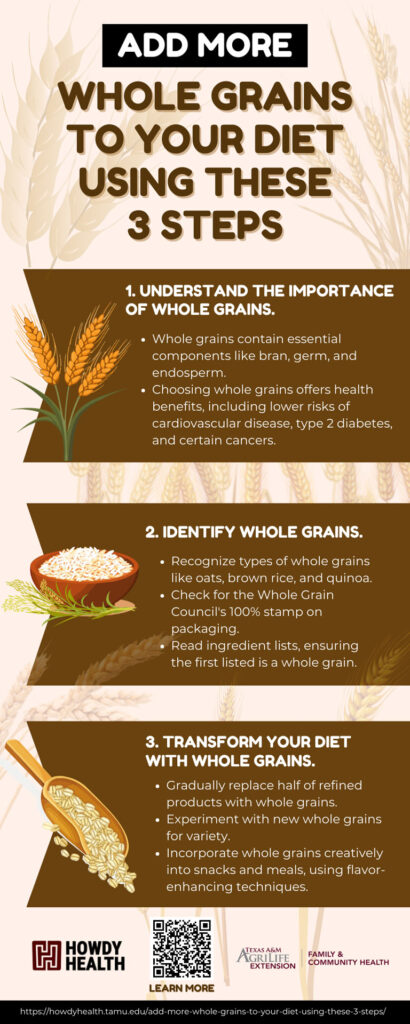A healthy dietary pattern should incorporate more whole grains while limiting the intake of refined grains.1 Grains are important sources of energy, dietary fiber, and several vitamins and minerals. When choosing foods made with grains, make at least 1/2 of your choices as whole grains.
While you may know that whole grains are better for your health, taking action to make that change can be a challenge. Understanding the importance of whole grains, familiarizing yourself with healthier alternatives, and learning practical ways to implement the changes into everyday life can give you the motivation and confidence needed to make the shift.
Step 1: Understanding Why We Should Eat Whole Grains
All grains must have their hull and husk removed to be edible.5 There are three parts to a grain kernel: the bran, germ, and endosperm.
- Bran is the outer fiber-rich shell, which also contains antioxidants, B vitamins, phytochemicals, and minerals.
- Germ is the nutrient-packed inner core of the kernel, which contains antioxidants, phytochemicals, B vitamins, vitamin E, as well as some protein, minerals, and healthy unsaturated fats.
- Endosperm is the middle layer and largest part of the grain kernel, which contains starchy carbohydrates, protein, and small amounts of vitamins and minerals.2,3,4
Whole grains include all three parts of a grain kernel. During the milling process, grains are refined to enhance their texture and shelf life6 by removing the nutrient-rich bran and germ, leaving only the starchy endosperm in refined grains.5 Refined grains are often enriched with many nutrients that are lost during this milling process. However, dietary fiber, antioxidants, phytochemicals, and heart healthy fats that are known to have disease fighting properties are not restored.
According to research studies, choosing whole grains over refined grains offers several health benefits in addition to improving the nutritional value of your diet. Here are some of those health benefits:
- Increased intake of whole grains is associated with a lower occurrence of, and death from cardiovascular disease, type 2 diabetes and some cancers.5,9,10
- A diet high in whole grains has been shown to be beneficial for the prevention and treatment of type 2 diabetes,10 and reduced risk of gastrointestinal disorders.5
- Whole grains could potentially play a role in lowering blood cholesterol levels, maintaining a healthy body weight, and reducing risk of obesity.10
These are all great reasons to begin adding more whole grains to your diet.
Step 2: Identifying What Products Contain Whole Grains
Now that you know why it’s important to add whole grains to your diet, let’s look at what products qualify as whole grains. Here are a few important things to know:
- Familiarize yourself with types of whole grains. Common whole grains include hulled barley (not pearled), bulgur, whole grain couscous, farro, kamut, oats, rye, spelt, triticale, and whole wheat. Common gluten-free whole grain options include amaranth, brown rice, buckwheat, corn, millet, quinoa, sorghum, teff, and wild rice.2,11,12
- Don’t rely on the color of the product. Not all whole grains are dark in color (e.g., white wheat is an example of a whole grain that is light in color).13 Additionally, some manufacturers add molasses or food coloring to give products a rich dark color, but that doesn’t mean they are whole grain products.
- Look for the Whole Grain Council’s 100% stamp on the product packaging. The whole grain stamp indicates that all grain ingredients in the product are made of whole grains and each serving has a full serving or more of whole grains.14,15 (Note: Not all whole grain foods have the stamp).
- Read the ingredients list. Many food products are made from a mixture of whole grains and refined grains. Only foods that are made with 100% whole grains are considered a whole grain food.7 Words on the packaging, like natural, organic, multigrain, stoneground, cracked wheat, seven-grain, bran, and even 100% wheat don’t necessarily mean the product is a whole grain product.11,16,17 The main way to know if a product is a whole grain product is to read the ingredients list (often found below the Nutrition Facts label).
- The name of a whole grain should be listed as the first ingredient (or second ingredient after water).1Items on the ingredient list appear in descending order by weight.
- Look for the keyword “whole” (e.g., whole wheat flour, whole grain cornmeal, whole buckwheat, whole oats, whole rye flour, etc.), or simply the name of the grain (e.g., oats, oatmeal, brown rice, wheatberries, etc.) at the beginning of the ingredients list.1,11
- Words that never describe whole grains include enriched flour, wheat flour, bran, wheat germ, and degermed or degerminated (on corn meal)18,19. If you find these terms at the beginning of the ingredients list, the product is not likely a whole grain product.
Step 3: Transforming Your Tastebuds
If you’ve been eating primarily refined grains, like white flour, pasta, and rice, you can make gradual and small changes, allowing time for you and your family to start enjoying the taste and benefits of whole grains. Here are some ideas to get you started:
- Switch by half. When cooking pasta or rice, replace half of the refined product with a whole grain product. For example, cooking half white and half brown rice together, or cooking white and 100% whole wheat pasta together. When baking, replace half your white flour with whole wheat flour. This allows you to get used to the new flavors and textures without making a drastic switch.
- Start with white whole wheat flour. White whole wheat flour contains all the parts of a grain kernel and offers the nutritional benefits of whole wheat flour with a milder taste, texture, and lighter color. For those who are accustomed to the taste and flavor of refined white flour, white whole wheat flour can help facilitate a smoother transition. Pay attention to the keyword “whole” to be sure you’re getting a whole grain product.18
- Add variety. Gradually start experimenting with whole grains that are new to you. The more variety you get, the better because each type of whole grain offers its own nutritional benefits. Add hulled barley to soups and buckwheat to pancakes. Choose oats for your morning breakfast, as a topping for yogurt, or in your baked goods. Choose farro, quinoa, wheatberries, or wild rice in place of white rice. Switch from flour to corn tortillas. Try sorghum flour in your pizza dough or use a whole wheat pita as the crust for your pizza toppings.16,18 Need some other ideas, visit the Whole Grain Council’s recipe site for a myriad of choices using all kinds of whole grains.20 Try it homemade or freshly baked. Go to your local bakery or try your hand at making homemade whole wheat or other whole grain breads. You can also ease your family into whole grain eating with a sweet disguise, like making whole grain blueberry muffins, banana bread, banana pancakes, or sweet zucchini bread.21 It can be so good hot out of the oven.
- Try as breading: Use crushed whole grains, cornmeal, or rolled oats as a coating for baked fish or chicken, rather than white breadcrumbs or batter made with white flour.
- Spice it up. Add herbs and spices as flavor enhancers by adding some pepper, garlic, cumin or a little fresh cilantro, thyme, or basil to your whole grains. combine whole grains with seasoned, roasted vegetables. You can make your meal more interesting by adding a sauce (think cheese sauce, bbq sauce, soy sauce, or chipotle sauce) or by topping it up with some toasted nuts and seeds (e.g. almond or sesame).
- Snack on it. Start with whole grain snacks. Don’t forget about corn – popcorn is a great whole grain snack. There are also a myriad of whole grain crackers available, just be sure to read the ingredients list to be sure you’re getting a whole grain product. Top them with guacamole, chicken or tuna salad, or a slice of cheese and apple for a flavorful bite.
However you make the switch, when deciding what grains to eat, choose options that are full of nutrients and limited in added sugars, saturated fat, and sodium.22
Want to learn more? Check out all our free Howdy Health programs to step into the habit of healthy.
Infographic
Download the PDF or share the image below to help others learn more about how to add more whole grains to their diet using these 3 steps.
Add More Whole Grains to Your Diet Using These 3 Steps – Infographic (pdf)
- U.S. Department of Agriculture and U.S. Department of Health and Human Services. Dietary Guidelines for Americans, 2020-2025. 9th Edition. Accessed October 9, 2023. https://www.dietaryguidelines.gov/sites/default/files/2020-12/Dietary_Guidelines_for_Americans_2020-2025.pdf
- T.H. Chan School of Public Health. Whole grains. The Nutrition Source. November 4, 2019. Accessed October 13, 2023. https://www.hsph.harvard.edu/nutritionsource/what-should-you-eat/whole-grains/2.
- Călinoiu LF, Vodnar DC. Whole grains and phenolic acids: A review on bioactivity, functionality, health benefits and bioavailability. Nutrients. 2018;10(11):1615. doi:10.3390/nu10111615.
- The Whole Grains Council. What is a whole grain? What is a Whole Grain? Accessed December 7, 2023. https://wholegrainscouncil.org/what-whole-grain.
- P. NP, Joye IJ. Dietary fibre from whole grains and their benefits on metabolic health. Nutrients. 2020;12(10):3045. doi:10.3390/nu12103045.
- U.S. Department of Agriculture. What are refined grains? ASKUSDA. October 25, 2023. Accessed December 7, 2023. https://ask.usda.gov/s/article/What-are-refined-grains.
- U.S. Department of Agriculture. Grains: What foods are in the grain group?. Accessed December 7, 2023. https://www.myplate.gov/eat-healthy/grains.
- Mayo Clinic. The whole truth about whole grains. December 10, 2022. Accessed December 7, 2023. https://www.mayoclinic.org/healthy-lifestyle/nutrition-and-healthy-eating/in-depth/whole-grains/art-20047826.
- Seal CJ, Courtin CM, Venema K, de Vries J. Health benefits of whole grain: Effects on dietary carbohydrate quality, the gut microbiome, and consequences of processing. Comprehensive Reviews in Food Science and Food Safety. 2021;20(3):2742-2768. doi:10.1111/1541-4337.12728.
- Tieri M, Ghelfi F, Vitale M, et al. Whole grain consumption and human health: An Umbrella Review of Observational Studies. International Journal of Food Sciences and Nutrition. 2020;71(6):668-677. doi:10.1080/09637486.2020.1715354
- McManus KD. Whole grains or no grains? food labels can be misleading. Harvard Health. March 22, 2023. Accessed December 7, 2023. https://www.health.harvard.edu/blog/whole-grain-or-no-grain-food-labels-can-be-misleading-2020093021025.
- Greenwald AL. Barley, farro, sorghum and more: 9 whole grains to try. Johns Hopkins Medicine. February 9, 2022. Accessed December 8, 2023. https://www.hopkinsmedicine.org/health/wellness-and-prevention/barley-farro-sorghum-and-more-9-whole-grains-to-try.
- The Whole Grains Council. Whole white wheat FAQ. Accessed December 8, 2023. https://wholegrainscouncil.org/whole-grains-101/whats-whole-grain-refined-grain/whole-white-wheat-faq.
- Food Insight. How to identify whole grains: A guide to food labeling. February 27, 2023. Accessed December 8, 2023. https://foodinsight.org/whole-story-on-whole-grains/.
- The Whole Grains Council. Whole grain stamp. Accessed December 8, 2023. https://wholegrainscouncil.org/whole-grain-stamp.
- The Whole Grains Council. How to spot whole grains – quick info. November 13, 2019. Accessed December 8, 2023. https://youtu.be/REokmkKjHVM.
- U.S. Department of Agriculture. Tips 10 choose MyPlate – New Mexico State University. June 2011. Accessed December 8, 2023. https://quayextension.nmsu.edu/documents/myplate-tip-sheets.pdf.
- Getz L. Deciphering whole grain food labels – separating fact from fiction. Today’s Dietitian. June 2012. Accessed December 8, 2023. https://www.todaysdietitian.com/newarchives/060112p44.shtml.
- The Whole Grains Council. Corn – October grain of the Month. Accessed December 8, 2023. https://wholegrainscouncil.org/whole-grains-101/grain-month-calendar/corn-%E2%80%93-october-grain-month.
- The Whole Grains Council. Recipes Accessed December 8, 2023. https://wholegrainscouncil.org/recipes.
- Leake L. Real food tips: 6 ways to ease the switch to whole grain. 100 Days of Real Food. July 29, 2021. Accessed December 8, 2023. https://www.100daysofrealfood.com/real-food-tips-6-ways-to-ease-the-switch-to-whole-grain/.
- U.S. Department of Agriculture. Make half your grains whole grains. MyPlate. Accessed December 8, 2023. https://www.myplate.gov/tip-sheet/make-half-your-grains-whole-grains.





